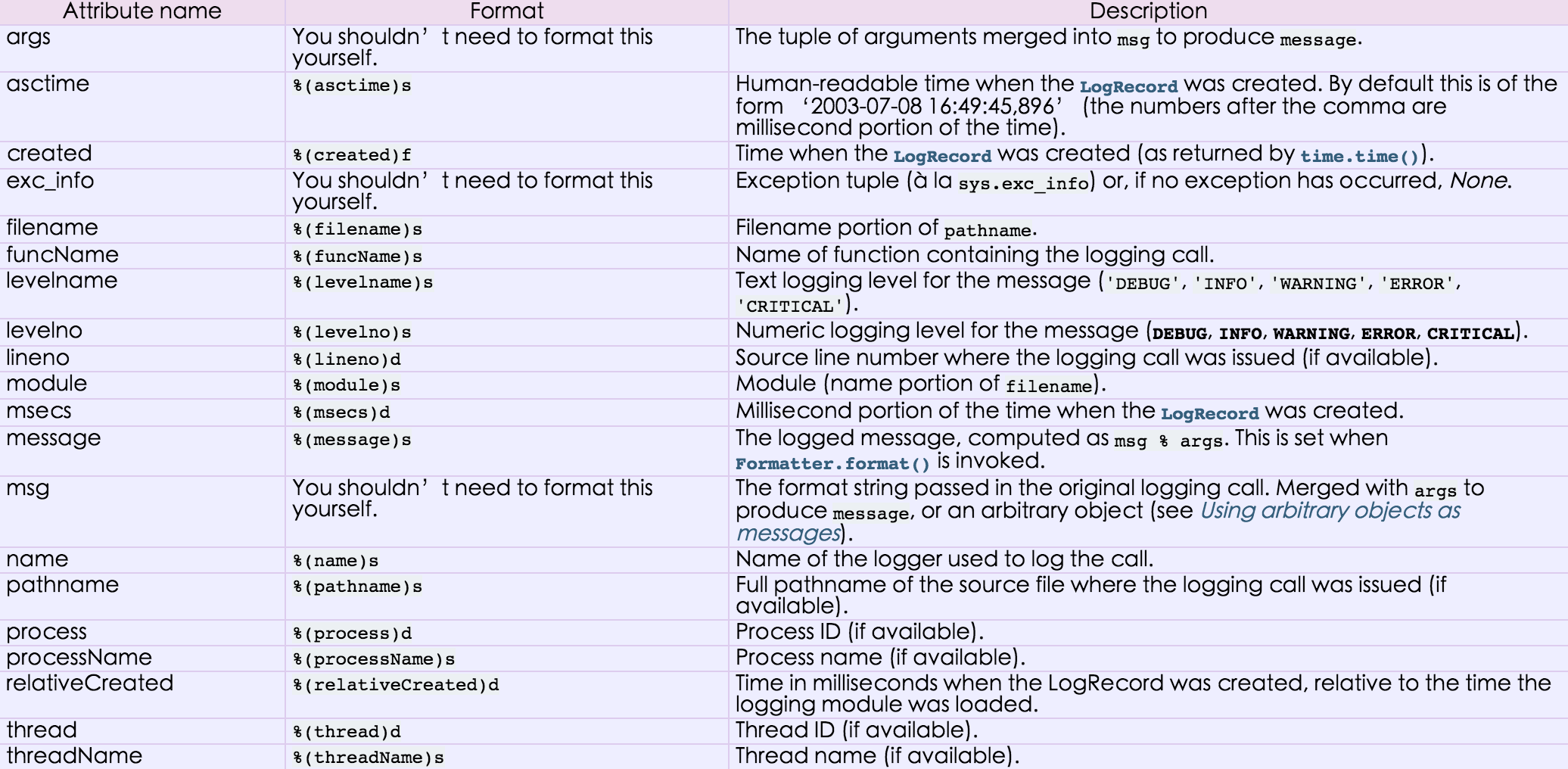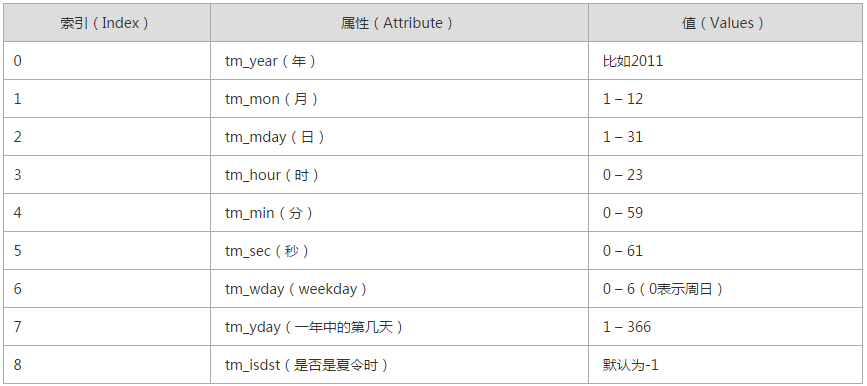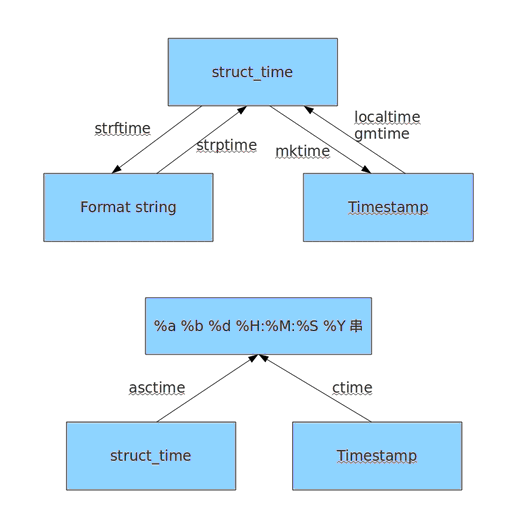python常用模块
模块,用一砣代码实现了某个功能的代码集合。
类似于函数式编程和面向过程编程,函数式编程则完成一个功能,其他代码用来调用即可,提供了代码的重用性和代码间的耦合。而对于一个复杂的功能来,可能需要多个函数才能完成(函数又可以在不同的.py文件中),n个 .py 文件组成的代码集合就称为模块。
如:os 是系统相关的模块;file是文件操作相关的模块
内置模块
1、OS
用于提供系统级别的操作
os.getcwd() 获取当前工作目录,即当前python脚本工作的目录路径
os.chdir("dirname") 改变当前脚本工作目录;相当于shell下cd
os.curdir 返回当前目录: ('.')
os.pardir 获取当前目录的父目录字符串名:('..')
os.makedirs('dirname1/dirname2') 可生成多层递归目录
os.removedirs('dirname1') 若目录为空,则删除,并递归到上一级目录,如若也为空,则删除,依此类推
os.mkdir('dirname') 生成单级目录;相当于shell中mkdir dirname
os.rmdir('dirname') 删除单级空目录,若目录不为空则无法删除,报错;相当于shell中rmdir dirname
os.listdir('dirname') 列出指定目录下的所有文件和子目录,包括隐藏文件,并以列表方式打印
os.remove() 删除一个文件
os.rename("oldname","newname") 重命名文件/目录
os.stat('path/filename') 获取文件/目录信息
os.sep 输出操作系统特定的路径分隔符,win下为"\\",Linux下为"/"
os.linesep 输出当前平台使用的行终止符,win下为"\t\n",Linux下为"\n"
os.pathsep 输出用于分割文件路径的字符串
os.name 输出字符串指示当前使用平台。win->'nt'; Linux->'posix'
os.system("bash command") 运行shell命令,直接显示
os.environ 获取系统环境变量
os.path.abspath(path) 返回path规范化的绝对路径
os.path.split(path) 将path分割成目录和文件名二元组返回
os.path.dirname(path) 返回path的目录。其实就是os.path.split(path)的第一个元素
os.path.basename(path) 返回path最后的文件名。如何path以/或\结尾,那么就会返回空值。即os.path.split(path)的第二个元素
os.path.exists(path) 如果path存在,返回True;如果path不存在,返回False
os.path.isabs(path) 如果path是绝对路径,返回True
os.path.isfile(path) 如果path是一个存在的文件,返回True。否则返回False
os.path.isdir(path) 如果path是一个存在的目录,则返回True。否则返回False
os.path.join(path1[, path2[, ...]]) 将多个路径组合后返回,第一个绝对路径之前的参数将被忽略
os.path.getatime(path) 返回path所指向的文件或者目录的最后存取时间
os.path.getmtime(path) 返回path所指向的文件或者目录的最后修改时间
更多模块访问:https://docs.python.org/2/library/os.html?highlight=os#module-os
二、sys
用于提供对解释器相关的操作
sys.argv 命令行参数List,第一个元素是程序本身路径
sys.exit(n) 退出程序,正常退出时exit(0)
sys.version 获取Python解释程序的版本信息
sys.maxint 最大的Int值
sys.path 返回模块的搜索路径,初始化时使用PYTHONPATH环境变量的值
sys.platform 返回操作系统平台名称
sys.stdout.write('please:')
val = sys.stdin.readline()[:-1]
三、hashlib
用于加密相关的操作,代替了md5模块和sha模块,主要提供SHA1,SHA224,SHA256,SHA384,SHA512,MD5算法
废弃
MD5
import md5
hash = md5.new()
hash.update('admin')
print hash.hexdigest()
SHA
import sha
hash = sha.new()
hash.update('admin')
print hash.hexdigest()
用于序列化的两个模块
- json,用于字符串 和 python数据类型间进行转换
- pickle,用于python特有的类型 和 python的数据类型间进行转换
Json模块提供了四个功能:dumps、dump、loads、load
pickle模块提供了四个功能:dumps、dump、loads、load
例:
import pickle
data = {‘k1’:123,’k2’:Hello}
#pickle.dumps 将数据通过特殊的形式转换为只有python语言认识的字符串
p_str =pickle.dumps(data)
print(p_str)
#pickle.dump将数据通过特殊的形式转换为只有python语言认识的字符串,并写入文件
with open(‘D:\result.pk’,’w’) as fp:
pickle.dump(data,fp)
import json
#json.dumps将数据通过特殊的形式转换为所有程序语言都认识的字符串
j_str = json.dumps(data)
print(j_str)
- os.system
- os.spawn*
- os.popen* --废弃
- popen2.* --废弃
- commands.* --废弃,3.x中被移除
-
import commands
result = commands.getoutput('cmd') result = commands.getstatus('cmd') result = commands.getstatusoutput('cmd’)以上执行shell命令的相关的模块和函数的功能均在 subprocess 模块中实现,并提供了更丰富的功能。
call
执行命令,返回状态码
12ret = subprocess.call(["ls", "-l"], shell=False)ret = subprocess.call("ls -l", shell=True)shell = True ,允许 shell 命令是字符串形式
check_call
执行命令,如果执行状态码是 0 ,则返回0,否则抛异常
12subprocess.check_call(["ls", "-l"])subprocess.check_call("exit 1", shell=True)check_output
执行命令,如果状态码是 0 ,则返回执行结果,否则抛异常
12subprocess.check_output(["echo", "Hello World!"])subprocess.check_output("exit 1", shell=True)subprocess.Popen(...)
用于执行复杂的系统命令
参数:
- args:shell命令,可以是字符串或者序列类型(如:list,元组)
- bufsize:指定缓冲。0 无缓冲,1 行缓冲,其他 缓冲区大小,负值 系统缓冲
- stdin, stdout, stderr:分别表示程序的标准输入、输出、错误句柄
- preexec_fn:只在Unix平台下有效,用于指定一个可执行对象(callable object),它将在子进程运行之前被调用
- close_sfs:在windows平台下,如果close_fds被设置为True,则新创建的子进程将不会继承父进程的输入、输出、错误管道。
所以不能将close_fds设置为True同时重定向子进程的标准输入、输出与错误(stdin, stdout, stderr)。 - shell:同上
- cwd:用于设置子进程的当前目录
- env:用于指定子进程的环境变量。如果env = None,子进程的环境变量将从父进程中继承。
- universal_newlines:不同系统的换行符不同,True -> 同意使用 \n
- startupinfo与createionflags只在windows下有效
将被传递给底层的CreateProcess()函数,用于设置子进程的一些属性,如:主窗口的外观,进程的优先级等等
import subprocess ret1 = subprocess.Popen(["mkdir","t1"]) ret2 = subprocess.Popen("mkdir t2", shell=True)终端输入的命令分为两种:
- 输入即可得到输出,如:ifconfig
- 输入进行某环境,依赖再输入,如:python
代码1import subprocess obj = subprocess.Popen("mkdir t3", shell=True, cwd='/home/dev’,)代码2
import subprocess obj = subprocess.Popen(["python"], stdin=subprocess.PIPE, stdout=subprocess.PIPE, stderr=subprocess.PIPE) obj.stdin.write('print 1 \n ') obj.stdin.write('print 2 \n ') obj.stdin.write('print 3 \n ') obj.stdin.write('print 4 \n ') obj.stdin.close() cmd_out = obj.stdout.read() obj.stdout.close() cmd_error = obj.stderr.read() obj.stderr.close()代码三 print cmd_out print cmd_error
import subprocess obj = subprocess.Popen(["python"], stdin=subprocess.PIPE, stdout=subprocess.PIPE, stderr=subprocess.PIPE) obj.stdin.write('print 1 \n ') obj.stdin.write('print 2 \n ') obj.stdin.write('print 3 \n ') obj.stdin.write('print 4 \n ') out_error_list = obj.communicate() print out_error_list代码四
import subprocess obj = subprocess.Popen(["python"], stdin=subprocess.PIPE, stdout=subprocess.PIPE, stderr=subprocess.PIPE) out_error_list = obj.communicate('print "hello"') print out_error_list更多在这里:https://docs.python.org/2/library/subprocess.html?highlight=subprocess#frequently-used-arguments
六、shutil
高级的 文件、文件夹、压缩包 处理模块
shutil.copyfileobj(fsrc, fdst[, length])
将文件内容拷贝到另一个文件中,可以部分内容def copyfileobj(fsrc, fdst, length=16*1024): """copy data from file-like object fsrc to file-like object fdst""" while 1: buf = fsrc.read(length) if not buf: break fdst.write(buf)shutil.copyfile(src, dst)
拷贝文件
def copyfile(src, dst): """Copy data from src to dst""" if _samefile(src, dst): raise Error("`%s` and `%s` are the same file" % (src, dst)) for fn in [src, dst]: try: st = os.stat(fn) except OSError: # File most likely does not exist pass else: # XXX What about other special files? (sockets, devices...) if stat.S_ISFIFO(st.st_mode): raise SpecialFileError("`%s` is a named pipe" % fn) with open(src, 'rb') as fsrc: with open(dst, 'wb') as fdst: copyfileobj(fsrc, fdst)shutil.copymode(src, dst)
仅拷贝权限。内容、组、用户均不变def copymode(src, dst): """Copy mode bits from src to dst""" if hasattr(os, 'chmod'): st = os.stat(src) mode = stat.S_IMODE(st.st_mode) os.chmod(dst, mode)shutil.copystat(src, dst)
拷贝状态的信息,包括:mode bits, atime, mtime, flagsdef copystat(src, dst): """Copy all stat info (mode bits, atime, mtime, flags) from src to dst""" st = os.stat(src) mode = stat.S_IMODE(st.st_mode) if hasattr(os, 'utime'): os.utime(dst, (st.st_atime, st.st_mtime)) if hasattr(os, 'chmod'): os.chmod(dst, mode) if hasattr(os, 'chflags') and hasattr(st, 'st_flags'): try: os.chflags(dst, st.st_flags) except OSError, why: for err in 'EOPNOTSUPP', 'ENOTSUP': if hasattr(errno, err) and why.errno == getattr(errno, err): break else: raiseshutil.copy(src, dst)
拷贝文件和权限
def copy(src, dst): """Copy data and mode bits ("cp src dst"). The destination may be a directory. """ if os.path.isdir(dst): dst = os.path.join(dst, os.path.basename(src)) copyfile(src, dst) copymode(src, dst)shutil.copy2(src, dst)
拷贝文件和状态信息def copy2(src, dst): """Copy data and all stat info ("cp -p src dst"). The destination may be a directory. """ if os.path.isdir(dst): dst = os.path.join(dst, os.path.basename(src)) copyfile(src, dst) copystat(src, dst)shutil.ignore_patterns(*patterns)
shutil.copytree(src, dst, symlinks=False, ignore=None)
递归的去拷贝文件例如:copytree(source, destination, ignore=ignore_patterns('*.pyc', 'tmp*’))
def ignore_patterns(*patterns): """Function that can be used as copytree() ignore parameter. Patterns is a sequence of glob-style patterns that are used to exclude files""" def _ignore_patterns(path, names): ignored_names = [] for pattern in patterns: ignored_names.extend(fnmatch.filter(names, pattern)) return set(ignored_names) return _ignore_patterns def copytree(src, dst, symlinks=False, ignore=None): """Recursively copy a directory tree using copy2(). The destination directory must not already exist. If exception(s) occur, an Error is raised with a list of reasons. If the optional symlinks flag is true, symbolic links in the source tree result in symbolic links in the destination tree; if it is false, the contents of the files pointed to by symbolic links are copied. The optional ignore argument is a callable. If given, it is called with the `src` parameter, which is the directory being visited by copytree(), and `names` which is the list of `src` contents, as returned by os.listdir(): callable(src, names) -> ignored_names Since copytree() is called recursively, the callable will be called once for each directory that is copied. It returns a list of names relative to the `src` directory that should not be copied. XXX Consider this example code rather than the ultimate tool. """ names = os.listdir(src) if ignore is not None: ignored_names = ignore(src, names) else: ignored_names = set() os.makedirs(dst) errors = [] for name in names: if name in ignored_names: continue srcname = os.path.join(src, name) dstname = os.path.join(dst, name) try: if symlinks and os.path.islink(srcname): linkto = os.readlink(srcname) os.symlink(linkto, dstname) elif os.path.isdir(srcname): copytree(srcname, dstname, symlinks, ignore) else: # Will raise a SpecialFileError for unsupported file types copy2(srcname, dstname) # catch the Error from the recursive copytree so that we can # continue with other files except Error, err: errors.extend(err.args[0]) except EnvironmentError, why: errors.append((srcname, dstname, str(why))) try: copystat(src, dst) except OSError, why: if WindowsError is not None and isinstance(why, WindowsError): # Copying file access times may fail on Windows pass else: errors.append((src, dst, str(why))) if errors: raise Error, errorsshutil.rmtree(path[, ignore_errors[, onerror]])
递归的去删除文件def rmtree(path, ignore_errors=False, onerror=None): """Recursively delete a directory tree. If ignore_errors is set, errors are ignored; otherwise, if onerror is set, it is called to handle the error with arguments (func, path, exc_info) where func is os.listdir, os.remove, or os.rmdir; path is the argument to that function that caused it to fail; and exc_info is a tuple returned by sys.exc_info(). If ignore_errors is false and onerror is None, an exception is raised. """ if ignore_errors: def onerror(*args): pass elif onerror is None: def onerror(*args): raise try: if os.path.islink(path): # symlinks to directories are forbidden, see bug #1669 raise OSError("Cannot call rmtree on a symbolic link") except OSError: onerror(os.path.islink, path, sys.exc_info()) # can't continue even if onerror hook returns return names = [] try: names = os.listdir(path) except os.error, err: onerror(os.listdir, path, sys.exc_info()) for name in names: fullname = os.path.join(path, name) try: mode = os.lstat(fullname).st_mode except os.error: mode = 0 if stat.S_ISDIR(mode): rmtree(fullname, ignore_errors, onerror) else: try: os.remove(fullname) except os.error, err: onerror(os.remove, fullname, sys.exc_info()) try: os.rmdir(path) except os.error: onerror(os.rmdir, path, sys.exc_info())shutil.move(src, dst)
递归的去移动文件def move(src, dst): """Recursively move a file or directory to another location. This is similar to the Unix "mv" command. If the destination is a directory or a symlink to a directory, the source is moved inside the directory. The destination path must not already exist. If the destination already exists but is not a directory, it may be overwritten depending on os.rename() semantics. If the destination is on our current filesystem, then rename() is used. Otherwise, src is copied to the destination and then removed. A lot more could be done here... A look at a mv.c shows a lot of the issues this implementation glosses over. """ real_dst = dst if os.path.isdir(dst): if _samefile(src, dst): # We might be on a case insensitive filesystem, # perform the rename anyway. os.rename(src, dst) return real_dst = os.path.join(dst, _basename(src)) if os.path.exists(real_dst): raise Error, "Destination path '%s' already exists" % real_dst try: os.rename(src, real_dst) except OSError: if os.path.isdir(src): if _destinsrc(src, dst): raise Error, "Cannot move a directory '%s' into itself '%s'." % (src, dst) copytree(src, real_dst, symlinks=True) rmtree(src) else: copy2(src, real_dst) os.unlink(src)shutil.make_archive(base_name, format,...)
创建压缩包并返回文件路径,例如:zip、tar
- base_name: 压缩包的文件名,也可以是压缩包的路径。只是文件名时,则保存至当前目录,否则保存至指定路径,
如:www =>保存至当前路径
如:/Users/wupeiqi/www =>保存至/Users/wupeiqi/ - format: 压缩包种类,“zip”, “tar”, “bztar”,“gztar”
- root_dir: 要压缩的文件夹路径(默认当前目录)
- owner: 用户,默认当前用户
- group: 组,默认当前组
- logger: 用于记录日志,通常是logging.Logger对象
#将 /Users/wupeiqi/Downloads/test 下的文件打包放置当前程序目录import shutilret = shutil.make_archive("wwwwwwwwww", 'gztar', root_dir='/Users/wupeiqi/Downloads/test')#将 /Users/wupeiqi/Downloads/test 下的文件打包放置 /Users/wupeiqi/目录import shutilret = shutil.make_archive("/Users/wupeiqi/wwwwwwwwww", 'gztar', root_dir='/Users/wupeiqi/Downloads/test’)代码案例:def make_archive(base_name, format, root_dir=None, base_dir=None, verbose=0, dry_run=0, owner=None, group=None, logger=None): """Create an archive file (eg. zip or tar). 'base_name' is the name of the file to create, minus any format-specific extension; 'format' is the archive format: one of "zip", "tar", "bztar" or "gztar". 'root_dir' is a directory that will be the root directory of the archive; ie. we typically chdir into 'root_dir' before creating the archive. 'base_dir' is the directory where we start archiving from; ie. 'base_dir' will be the common prefix of all files and directories in the archive. 'root_dir' and 'base_dir' both default to the current directory. Returns the name of the archive file. 'owner' and 'group' are used when creating a tar archive. By default, uses the current owner and group. """ save_cwd = os.getcwd() if root_dir is not None: if logger is not None: logger.debug("changing into '%s'", root_dir) base_name = os.path.abspath(base_name) if not dry_run: os.chdir(root_dir) if base_dir is None: base_dir = os.curdir kwargs = {'dry_run': dry_run, 'logger': logger} try: format_info = _ARCHIVE_FORMATS[format] except KeyError: raise ValueError, "unknown archive format '%s'" % format func = format_info[0] for arg, val in format_info[1]: kwargs[arg] = val if format != 'zip': kwargs['owner'] = owner kwargs['group'] = group try: filename = func(base_name, base_dir, **kwargs) finally: if root_dir is not None: if logger is not None: logger.debug("changing back to '%s'", save_cwd) os.chdir(save_cwd) return filenameshutil 对压缩包的处理是调用 ZipFile 和 TarFile 两个模块来进行的,详细:
import zipfile
zipfile压缩解压 # 压缩 z = zipfile.ZipFile('laxi.zip', 'w') z.write('a.log') z.write('data.data') z.close() # 解压 z = zipfile.ZipFile('laxi.zip', 'r') z.extractall() z.close()tarfile压缩解压
import tarfile # 压缩 tar = tarfile.open('your.tar','w') tar.add('/Users/wupeiqi/PycharmProjects/bbs2.zip', arcname='bbs2.zip') tar.add('/Users/wupeiqi/PycharmProjects/cmdb.zip', arcname='cmdb.zip') tar.close() # 解压 tar = tarfile.open('your.tar','r') tar.extractall() # 可设置解压地址 tar.close()七、ConfigParser
用于对特定的配置进行操作,当前模块的名称在 python 3.x 版本中变更为 configparser。
importConfigParserconfig=ConfigParser.ConfigParser()config.read('i.cfg')# ########## 读 ###########secs = config.sections()#print secs#options = config.options('group2')#print options#item_list = config.items('group2')#print item_list#val = config.get('group1','key')#val = config.getint('group1','key')# ########## 改写 ###########sec = config.remove_section('group1')#config.write(open('i.cfg', "w"))#sec = config.has_section('wupeiqi')#sec = config.add_section('wupeiqi')#config.write(open('i.cfg', "w"))#config.set('group2','k1',11111)#config.write(open('i.cfg', "w"))#config.remove_option('group2','age')#config.write(open('i.cfg', "w”))八、logging用于便捷记录日志且线程安全的模块
1234567891011121314importlogginglogging.basicConfig(filename='log.log',format='%(asctime)s - %(name)s - %(levelname)s -%(module)s: %(message)s',datefmt='%Y-%m-%d %H:%M:%S %p',level=10)logging.debug('debug')logging.info('info')logging.warning('warning')logging.error('error')logging.critical('critical')logging.log(10,'log')对于等级:
12345678CRITICAL=50FATAL=CRITICALERROR=40WARNING=30WARN=WARNINGINFO=20DEBUG=10NOTSET=0只有大于当前日志等级的操作才会被记录。
对于格式,有如下属性可是配置:
 九、time
九、time时间相关的操作,时间有三种表示方式:
- 时间戳 1970年1月1日之后的秒,即:time.time()
- 格式化的字符串 2014-11-11 11:11, 即:time.strftime('%Y-%m-%d')
- 结构化时间 元组包含了:年、日、星期等... time.struct_time 即:time.localtime()
printtime.time()printtime.mktime(time.localtime())printtime.gmtime()#可加时间戳参数printtime.localtime()#可加时间戳参数printtime.strptime('2014-11-11','%Y-%m-%d')printtime.strftime('%Y-%m-%d')#默认当前时间printtime.strftime('%Y-%m-%d',time.localtime())#默认当前时间printtime.asctime()printtime.asctime(time.localtime())printtime.ctime(time.time())importdatetime'''datetime.date:表示日期的类。常用的属性有year, month, daydatetime.time:表示时间的类。常用的属性有hour, minute, second, microseconddatetime.datetime:表示日期时间datetime.timedelta:表示时间间隔,即两个时间点之间的长度timedelta([days[, seconds[, microseconds[, milliseconds[, minutes[, hours[, weeks]]]]]]])strftime("%Y-%m-%d")'''importdatetimeprintdatetime.datetime.now()printdatetime.datetime.now()-datetime.timedelta(days=5)

十、re
re模块用于对python的正则表达式的操作。
字符:
. 匹配除换行符以外的任意字符
\w 匹配字母或数字或下划线或汉字
\s 匹配任意的空白符
\d 匹配数字
\b 匹配单词的开始或结束
^ 匹配字符串的开始
$ 匹配字符串的结束次数:
* 重复零次或更多次
+ 重复一次或更多次
? 重复零次或一次
{n} 重复n次
{n,} 重复n次或更多次
{n,m} 重复n到m次IP: ^(25[0-5]|2[0-4]\d|[0-1]?\d?\d)(\.(25[0-5]|2[0-4]\d|[0-1]?\d?\d)){3}$ 手机号: ^1[3|4|5|8][0-9]\d{8}$1、match(pattern, string, flags=0)
从起始位置开始根据模型去字符串中匹配指定内容,匹配单个
- 正则表达式
- 要匹配的字符串
- 标志位,用于控制正则表达式的匹配方式
import re obj = re.match('\d+', '123uuasf') if obj: print obj.group()
2、search(pattern, string, flags=0)
根据模型去字符串中匹配指定内容,匹配单个
import re obj = re.search('\d+', 'u123uu888asf') if obj: print obj.group()3、group和groups
a = "123abc456" print re.search("([0-9]*)([a-z]*)([0-9]*)", a).group() print re.search("([0-9]*)([a-z]*)([0-9]*)", a).group(0) print re.search("([0-9]*)([a-z]*)([0-9]*)", a).group(1) print re.search("([0-9]*)([a-z]*)([0-9]*)", a).group(2) print re.search("([0-9]*)([a-z]*)([0-9]*)", a).groups()4、findall(pattern, string, flags=0)
上述两中方式均用于匹配单值,即:只能匹配字符串中的一个,如果想要匹配到字符串中所有符合条件的元素,则需要使用 findall。
import re obj = re.findall('\d+', 'fa123uu888asf') print obj5、sub(pattern, repl, string, count=0, flags=0)
用于替换匹配的字符串
content = "123abc456" new_content = re.sub('\d+', 'sb', content) # new_content = re.sub('\d+', 'sb', content, 1) print new_content相比于str.replace功能更加强大
6、split(pattern, string, maxsplit=0, flags=0)
根据指定匹配进行分组
content = "'1 - 2 * ((60-30+1*(9-2*5/3+7/3*99/4*2998+10*568/14))-(-4*3)/(16-3*2) )'" new_content = re.split('\*', content) # new_content = re.split('\*', content, 1) print new_contentcontent = "'1 - 2 * ((60-30+1*(9-2*5/3+7/3*99/4*2998+10*568/14))-(-4*3)/(16-3*2) )'" new_content = re.split('[\+\-\*\/]+', content) # new_content = re.split('\*', content, 1) print new_contentinpp = '1-2*((60-30 +(-40-5)*(9-2*5/3 + 7 /3*99/4*2998 +10 * 568/14 )) - (-4*3)/ (16-3*2))' inpp = re.sub('\s*','',inpp) new_content = re.split('\(([\+\-\*\/]?\d+[\+\-\*\/]?\d+){1}\)', inpp, 1) print new_content相比于str.split更加强大
计算器原码:http://www.cnblogs.com/wupeiqi/articles/4949995.html
十一、random
随机数
mport random
print random.random()
print random.randint(1,2)
print random.randrange(1,10)
随机验证码实例:importrandomcheckcode=''foriinrange(4):current=random.randrange(0,4)ifcurrent !=i:temp=chr(random.randint(65,90))else:temp=random.randint(0,9)checkcode+=str(temp)printcheckcode此文档采用:http://www.cnblogs.com/wupeiqi/articles/4963027.html






